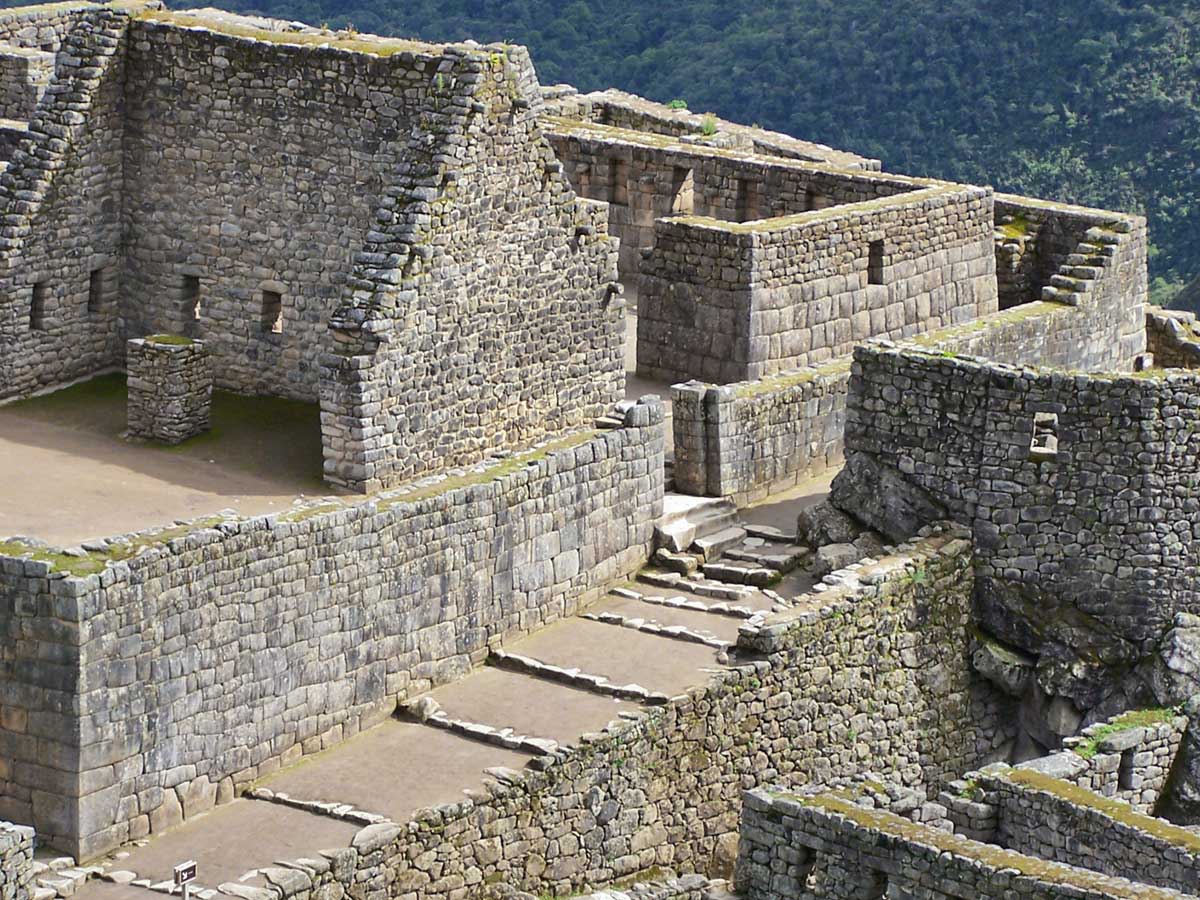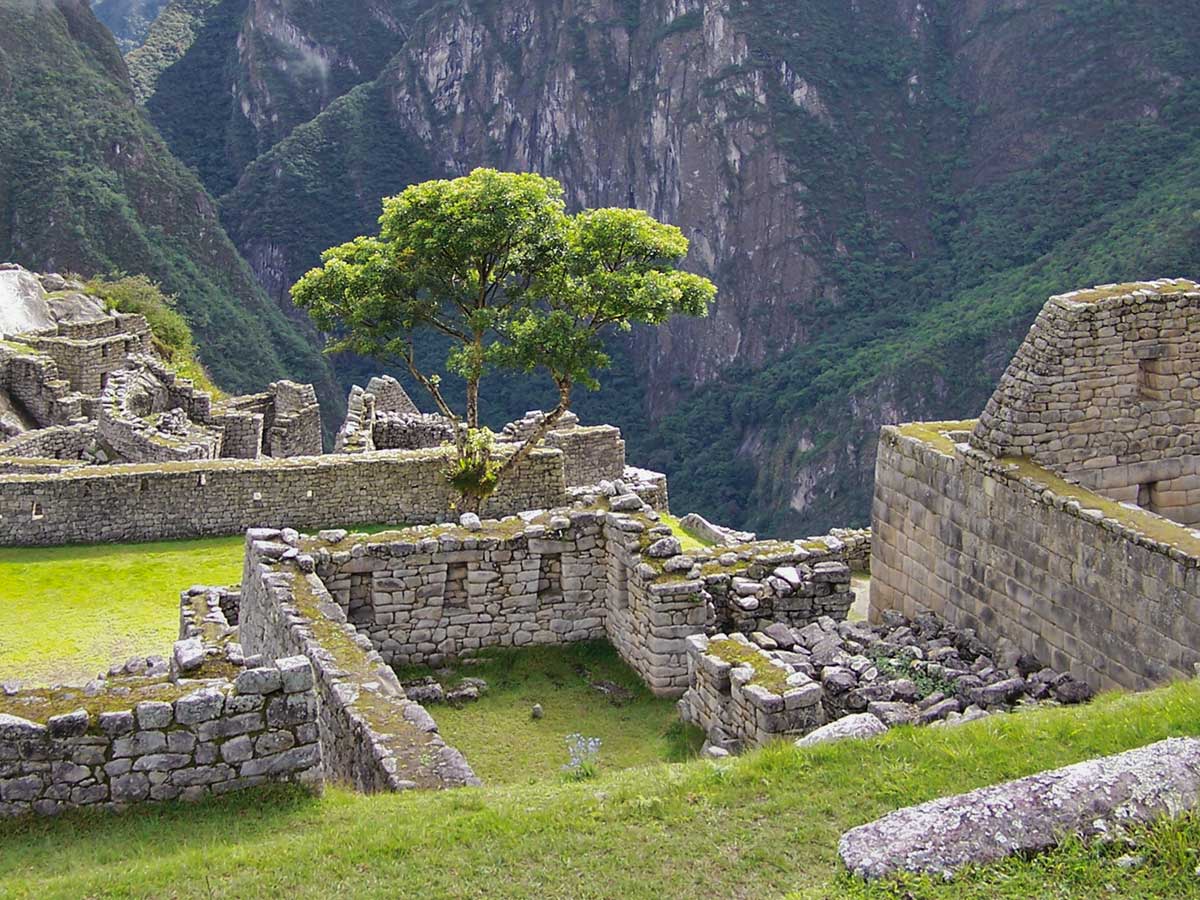
Machu Picchu was "llaqta“ - an ancient Andean Inca town - located in the Eastern Cordillera of southern Peru, in the Andes mountain range, just 80 kilometres away from the city of Cuzco. It was built east of the depression formed by the mountain systems of Machu Picchu and Huayna Picchu at 2,430 meters above sea level.
It is named after the mountain above the citadel - "Machu Picchu", which means "Old Mountain" in the native language of Quechua, an autochthonous language that is still very much present in most locations in the south of the country.
Machu Picchu is considered, at the same time, a masterpiece of architecture and engineering. Its peculiar architectural and landscape characteristics, and the veil of mystery that has woven around it much of the literature published on the site, have made it one of the most popular tourist destinations on the planet
According to documents from the middle of the 16th century, the citadel had a private character. However, some of its best constructions and the evident ceremonial character of the main access road to the "llaqta" show its origin before Pachacutec and its supposed use as a religious sanctuary. It is also believed that the building was intended as a refuge for the highest Inca aristocracy of the time due to the difficulty of its access. Part of this theory comes from the level of luxury found in the ruins of some Machu Picchu buildings. The two uses, the palace and the sanctuary, would not be incompatible. Although its alleged military nature is questioned, later studies have shown that in the case of a fortress, missing fortifications would be necessary.
The Picchu Ravine, located halfway between the Andes and the Amazon Rainforest, was a region colonized by Andean populations, not a jungle, from the Vilcabamba and Sacred Valley regions, in Cuzco, in search of an expansion of their agricultural borders. Archaeological evidence indicates that agriculture was practised in the region since at least 760 BC. A demographic explosion occurred in the Middle Horizon Period, from 900 AD, by groups not historically documented but possibly linked to the Tampu ethnic group of Urubamba. It is believed that these towns could have formed part of the Ayarmaca federation, rivals of the first Incas of Cuzco, during this period the "constructed" agricultural area (platforms) expanded considerably. However, the specific location of the city that concerns us (the rocky ridge that joins the mountains Machu Picchu and Huayna Picchu) does not show signs of having had buildings before the 15th century.
Around 1430, during the Pachacutec (1438 – 1470) campaign towards Vilcabamba, the Picchu Ravine was conquered by the first Inca of "Tahuantinsuyo" (Inca Empire). The location of Machu Picchu must have impressed the monarch due to its special characteristics in the sacred geography of Cusco, and for this reason, he ordered the construction of a city complex around 1450 on a mountain saddle between the mountains with highly luxurious civil and religious buildings. Machu Picchu is undoubtedly one of the greatest works of Pachacutec.
Machu Picchu is thought to have had a mobile population like most Andean Incan towns, ranging from 300 to 1,000 elite members (perhaps members of Pachacutec "panaca" - a family of all descendants of the monarch, except the son who succeeded in command) and "acllas" (the virgins of the sun god). It turned out that the agricultural power was formed by "mitma", slaves from different parts of the empire. It is estimated that the largest number of them were the Chankas, who also built the city. They were enslaved and expropriated from their lands (now Apurímac and Ayacucho) after being defeated by Pachacutec.
The valley of the river flowing into the gorge below Machu Picchu formed a densely populated area that had dramatically increased its agricultural productivity since the Inca occupation in 1440. The Incas built many administrative centres there, which supplied agriculturally the above-located city. There were 8 roads leading to Machu Picchu!
After the death of Pachacutec, and by Inca royal customs, the city and the rest of his personal property passed into the administration of his „panaca“.
Machu Picchu must have partly lost its importance as it had to compete in prestige with the personal properties of the sovereign successors - Tupac Yupanqui (1470-1493) and Huayna Capac (1493-1529). The opening of a safer and wider road between Ollantaytambo and Vilcabamba (in the Amaybamba Valley) made the route of the Picchu ravine less used.

The Inca civil war (1531-32) and the Spanish irruption in Cusco in 1534 must-have affected the life of Machu Picchu considerably. The peasant mass of the region was composed mainly of "mitmas", slaves from different nations conquered by the Incas, taken by force to that place. They took advantage of the fall of the Cusco economic system to return to their lands of origin. The Inca resistance against the Spanish led by Manco Inca in 1536 summoned the nobles of the nearby regions to join his court in exile in Vilcabamba and is very likely that the main nobles of Machu Picchu then left the city.
In 1572, Machu Picchu was completely abandoned abruptly. However, it is possible that most of the population died of smallpox before the Spanish conquerors came to the area. The Spaniards seemed to know of a place called Picchu, although there are no records of the Spaniards visiting this distant city. The conquerors destroyed the sacrificial stones in other areas but Machu Picchu remained intact, which suggests that the Spaniards never visited the city!
It was discovered in 1911 by Hiram Bingham, an American history professor, thanks to contacts with the settlers of that region who guided him to the area in question. His astonishment was unequalled.
By 1976, 30% of Machu Picchu had been restored, and restoration work has been continuing.
1981 - Machu Picchu was declared a Peruvian Historical Sanctuary.
1983 - the whole cultural and ecological complex known as the Historic Sanctuary of Machu Picchu has been added to the UNESCO World Heritage List.
On 7 July 2007, Machu Picchu was declared one of the New Seven Wonders of the Modern World in a ceremony held in Portugal, which was attended by one hundred million voters from around the world.

As we do not have historical records of the construction of Machu Picchu, it is difficult to determine exactly the date when the work was done. It is estimated that the construction was carried out in the mid-15th century. However, 14 carbon tests were carried out on the remains found in the ruins, its construction dates from 1450 during the rule of the Inca Pachacutec.
Among the numerous archaeological sites nestled in Cuzco, Machu Picchu and its storied past have withstood the test of time, escaping the destructive forces of the Spanish conquistadors.
Machu Picchu's citadel has admirably preserved its original structures, many of which were meticulously chosen by Pachacutec. Upon a granite plateau, this visionary leader initiated an immensely costly and ambitious project. The result was a citadel designed to endure for all eternity.
Each architectural marvel within Machu Picchu served a distinct purpose: religious, administrative, political, and social. The two most pivotal aspects were the religious and administrative functions. The religious facet encompassed the daily rituals of life and the ceremonial journeys within Machu Picchu. In contrast, the administrative aspect was vital for overseeing the stringent controls that protected the Sanctuary and the Tambos—warehouses safeguarding the abundant products cultivated within the Citadel.

Machu Picchu stands as an enchanting haven for travelers and is honored with the UNESCO World Heritage Site status. Nestled amidst awe-inspiring landscapes, this place captivates with its intricate terraces, fortifications, and sanctuaries harmoniously etched into the rugged mountainside.
The site is segregated into two distinct sectors: the agricultural and urban sections. The agricultural sector boasts a network of terraces, irrigation channels, and aqueducts, ingeniously engineered by the Incas to cultivate crops on challenging terrain. In contrast, the urban sector comprises regal palaces, temples, and residences. The most renowned edifice is the Intihuatana, a remarkable carved stone believed to serve as an astronomical timepiece.
Explorers can wander through the Citadel, partake in guided tours, embark on unique hikes, and engage in various other activities. While it's possible to reach the ruins on foot, a dedicated bus service connects Machu Picchu Town to the Citadel, offering a convenient alternative.
Following your visit to the Citadel, you can explore the Machu Picchu Museum in town, an excellent resource for delving deeper into the history of Machu Picchu and the Inca civilization.
Machu Picchu, shrouded in enigma, undeniably showcases the Inca's architectural prowess and visionary ingenuity. Yet, it is also a place where enchantment, spirituality, and mysticism intertwine seamlessly with the breathtaking natural surroundings, providing a sanctuary for inspiration and self-discovery.
Visit our Inca Trail website to discover our range of train services and tourist packages. Allow us to tailor the perfect experience for you and manage every aspect of your Machu Picchu journey.
Only an emperor with a great mastery of his people could face a work of this magnitude. Pachacutec was the greatest Inca emperor and builder. We are grateful that we can admire the Wonder of the World today!
We hope this post has helped you learn a little bit more about Machu Picchu before your trip ... or, if you already have made it, understand better how it worked at the time.
During your visit to Machu Picchu, you can choose between a variety of tours. These range from a full-day excursion to Inca Trail tours through the Urubamba Valley of the Cusco region. The multi-day tours can be combined with climbing of the Huayna Picchu or Machu Picchu mountains, but you can also walk along the Urubamba Riverside, follow in the footsteps of the Inca Trail 4 days on their original paths, visit other archaeological sites such as Llactapata, Sacsaymarca, Phuyupatamarca, Wiñay Wayna and combine them with the Rainbow mountain tour. A trek through the Andes villages with living traditions. If the 4 days Inca Trail is sold out, the best hiking option is the Short Inca Trail, this trail is part of the Classic Inca Trail and alternative treks to Machu Picchu, such as Salkantay Trek. This trail is the best hiking alternative to the lost city of the Incas. There are no limits to your thirst for adventure around Machu Picchu!
On the day trips, you travel by train and make your way from Aguas Calientes to the paths that lead you through Machu Picchu.
